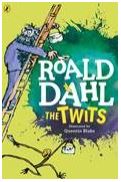This sequence of lessons uses the modelling phase of the teaching and learning cycle to focus on a close reading of the description of Roald Dahl’s character Mr Twit. Knowledge about language developed through this detailed reading can later be used to support students’ writing.
Text details
'The Twits'
Author: Roald Dahl, Published by: Jonathan Cape Ltd & Penguin Books Ltd.
The Twits by Roald Dahl tells the story of Mr Twit and Mrs Twit who do not like each other very much and enjoy playing awful tricks on each other.
Lesson overview
The focus of this series of lessons is on character development centring on Mr Twit. In his description of Mr Twit, Roald Dahl uses overt evaluative choices in expanded noun groups and prepositional phrases to build a description of his physical appearance and personality.
Through this sequence, students will examine the description of Mr Twit to understand:
- how the author describes the physical attributes of Mr Twit
- how the author describes the personality of Mr Twit (what he does, how he behaves, what he thinks)
- the language resources which develop the character.
The narrative is suitable for Levels 3 to 6.
Learning intention
We will read Roald Dahl’s description of Mr Twit and focus on the language choices which build a picture of Mr Twit and help us understand what kind of character he is.
Success criteria
I can identify, describe and explain the ways in which the author uses language to help the reader align or not with a character.
Theory/practice connections
As students move through primary school, they read and write texts which include more complex noun groups. In all kinds of texts, noun groups can be used to package ‘chunks’ of information, quite often in complex ways. Simple sentences can contain a considerable information for students to comprehend.
In narrative texts, noun groups often provide details about things, characters and places. When reading, it is helpful for students to see noun groups as a ‘chunk’ of information rather than a series of words (Derewianka, 2011, p.42).
Identifying details about a character in a narrative is one way of supporting students to interpret ways in which authors try to make us align, or not align, with characters through details which elaborate on their appearance and disposition.
Role of the reader
Text decoder, text participant, text user, text analyst.
Lessons
Access the first lesson